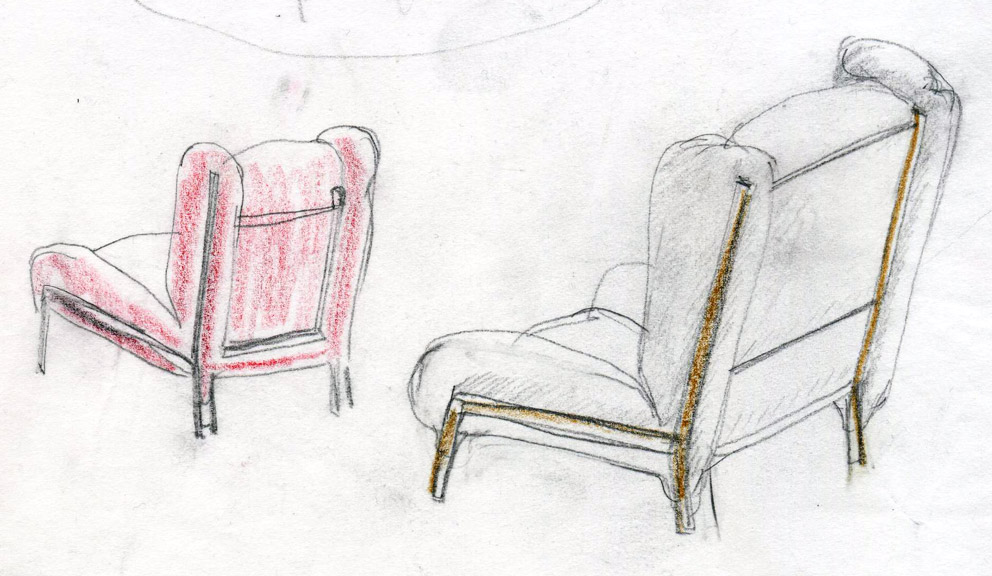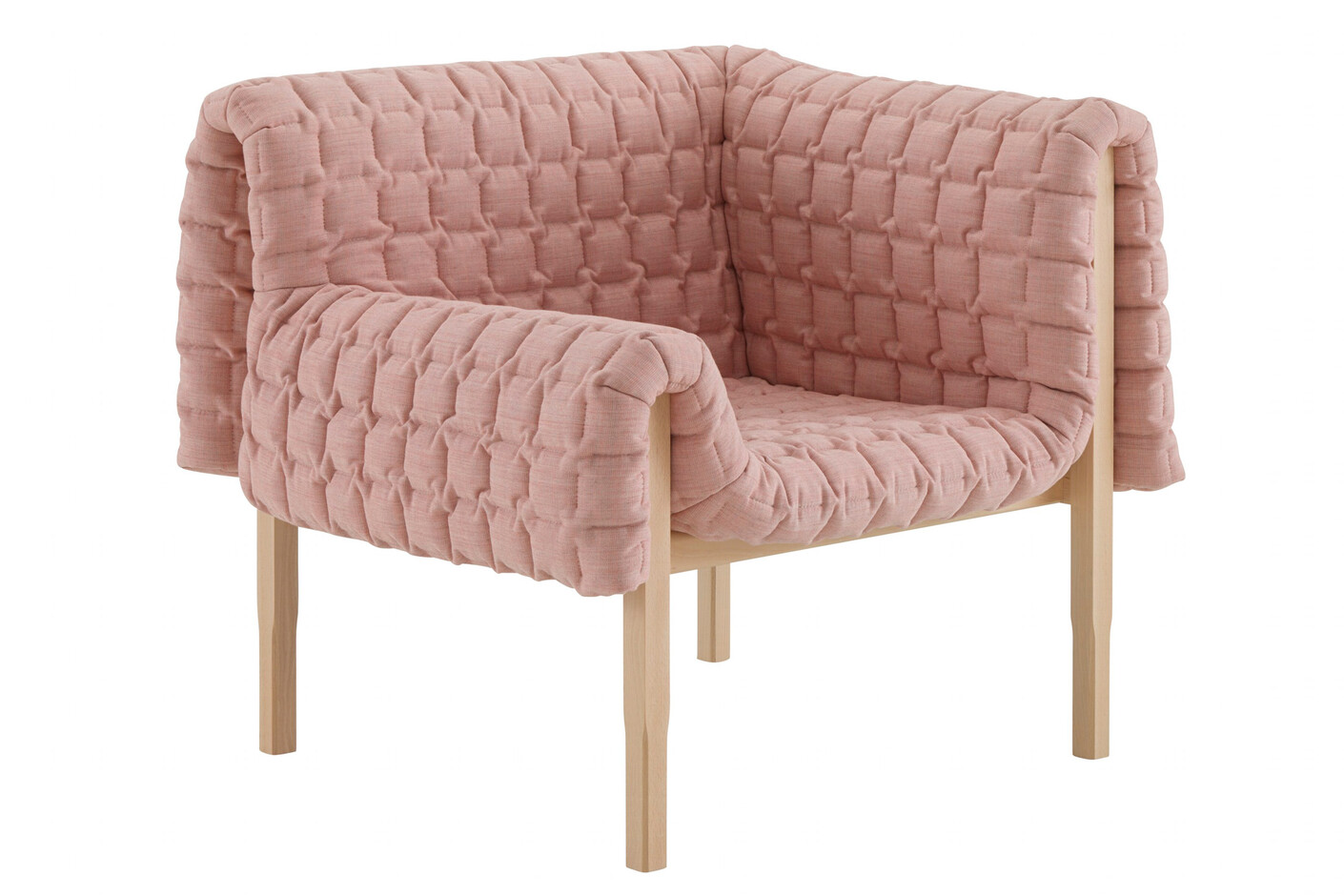Inga Sempé
| Feb 1, 2015
Inga Sempé is renowned for functional and innovative designs that provide elegant solutions, often with a poetic touch. Which is also the case with “Beau Fixe”, her latest project for Ligne Roset. The 47-year-old, who works not only for Ligne Roset, but also for companies such as Hay, Cappellini, Edra and Luceplan, emphasized a whole lot of comfort and ingenious technology for the armchair and the matching two-seat high-backed settee. The predecessor went by the name of “Ruché”, boasted a quilted upholstery top, was likewise designed for Ligne Roset, but looked quite different. Uta Abendroth spoke with the French designer about the idea and the technology, how she creates her products through teamwork, and why she feels attracted to small objects.

Uta Abendroth: Inga Sempé, were you intending with “Beau Fixe” to give the winged armchair a new lease of life in a more modern guise?
Inga Sempé: Precisely. This manner of thinking of something in a new way is essentially my work philosophy. It is simply the case that working on such a project tends to be quite boring. And if, as a designer, you are bored by a project, then that spells boredom for quite a protracted period of time. Which means it is in your own interest to at least think an object in a slightly new way and consider it a challenge. Now challenge is a big word for a thing that is actually quite “basic”. But that’s why I devoted extra time to the texture of the upholstery for “Beau Fixe”. I like working away at the technical details, even if you perhaps don’t notice that when it comes to the finished object. In my opinion you shouldn’t see the technology anyway. It is simply an interesting aspect for the designer. If a product looks technical, then it looks boring. I like to think of ballet dancers here. If the dancing looks technical, it is not modern dance but simply someone practicing. That applies to design, too.

Do you associate something personal with winged armchairs as a type?
Sempé: Most definitely! The holiday home I always went to as a child had those comfy armchairs. When I sit in such an armchair today I immediately feel great. That familiar feeling and memories of childhood … You can sit in that type of armchair in so many different ways when you’re small. But the fact that I especially like them did not make it any easier to try and find a new way of designing them. I didn’t want something nostalgic, as I detest such things.

What’s “Beau Fixe’s” underlying structure?
Sempé: There are only two elements, the metal frame and the upholstery. The frame is like a large pincer that holds a large one-piece blanket between its tongs. The pincer divides and folds the blanket into different parts that then form the armrests, the seat, the backrest and the wings. I wanted the structure not to be decorative from the feet to the headrest, but to be useful and remain visible. That way, the finished item still has something of a sketch about it.

Are you one of those designers who still draws by hand, or do you work solely on screen?
Sempé: I draw with a pencil but would work on screen if I was better able to do so. But we designers aren’t illustrators or professional drawers. The focus is on the project, not just the path to the final design. There are people who claim that if you can’t draw well you can’t realize good projects. That’s arrogant. The result depends on your “spirit”, not on the technology.

But the technology or technical knowhow really influences the finished product, does it not?
Sempé: Hmmm, a product is basically always the result of a cooperation with different people bringing their specialist knowledge to bear in the design process. The idea is to develop a product from a drawing. “Ruché” is an example of this, I believe. I felt the first prototype for “Ruché” felt so boring that I wanted to call off the entire project. But together we moved things forward. That’s one of the reasons why I like working with Ligne Roset, because with them you can develop the product together with the entire team, directly in the factory.

So working with a to-scale model is crucial for you?
Sempé: Most definitely. Small models always look great. What the Japanese mean with the term “kawaii”, as in “small and sweet”, applies to furniture, too. You can take the ugliest of things, shrink them to doll’s-house size, and, hey presto! They look brilliant. The difficulty is to make good objects on a true-to-life scale.
Did you also create the textile covers for “Beau Fixe”?
Sempé: The fabrics used for the “Beau Fixe” upholstery are not my brainchild. But I did design an upholstery cover with a small pattern. Sadly, it wasn’t ready in time.

At first sight, neither the armchair nor the settee look especially comfortable, meaning I was all the more taken by how soft and comfortable they are.
Sempé: A settee needn’t necessarily look super soft, even if it is. In the case of “Ruché”, at the beginning many people thought it was not really so soft, but it definitely is very comfortable. As a designer you can’t let yourself design a settee that isn’t comfy, unless it is destined for areas where people won’t spend much time. But as soon as a settee is meant for a home setting, then it has to be comfy.
To your mind, should form follow functionality?
Sempé: All kinds of form can follow a function. I don’t like aesthetic rules, as aesthetics can go in so many different directions. I always start with the function, but I do think that is not something that should be noticeable. We need more liberties than “form follows function”.

Quite apart from furniture, what else do you like designing?
Sempé: Designing furniture is actually something I don’t really like. Furniture is not the first thing I think of. I have always felt more attracted to small objects. Creatively speaking they give me far more scope than furniture, which always has to be designed with a view to the size of the human body. But in the end all objects are interesting as long as the company you are working with is interesting. For example, I designed woolen blankets for the Norwegian firm Røros Tweed, and ceramic tiles for the Italian brand Mutina. If there were a company that had a particular passion for making screwdrivers I would want to work with it! People you work with should trust you, otherwise you waste too much time and energy. Naturally I’m not an expert in anything, but when I really get into a project I become one.











